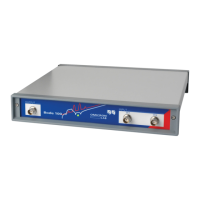37
Impedance/Reflection Mode
4.1.3 Quality Factor
An ideal inductor will be lossless irrespective of the amount of current flowing
through the winding. An ideal capacitor will be lossless irrespective of the
voltage applied to it. However, real inductors have a winding resistance due to
the metal wire forming the coils and real capacitors have a resistance due to the
used insulation material. These resistances cause a loss of inductive or
capacitive quality. For serial equivalent circuits, the quality factor is defined as
the ratio of the reactance to the resistance at a given frequency. For parallel
equivalent circuits, the quality factor is defined as the ratio of the resistance
to the reactance at a given frequency.The factor is a measure of the inductor’s
and capacitor’s efficiency. The higher the factor of a capacitor or inductor, the
closer the capacitor/inductor approaches the behavior of an ideal, lossless
component.
The factor calculated using the serial equivalent circuit is given by
(Eq. 4-14)
and using the parallel equivalent circuit is given by
(Eq. 4-15)
4.2 Example: Impedance/Reflection Measurement
Expected example duration: 20 minutes.
In this example you will learn step by step how to use the
Impedance/Reflection mode of the Bode 100.
How to:
• Measure the reflection coefficient at a frequency
• Set the bandwidth and amplitudes used for the measurement
• Connect the DUT for the impedance and reflection measurement
• Optimize the diagrams
• Work with the serial and parallel equivalent circuits
Question: What is the reflection coefficient in dB of the delivered IF filter input
at 10.7 MHz?
Q
Q
Q
Q
Q
Q
Imag Z()
Real Z()
-----------------------
X
s
R
s
--------
==
Q
Imag Y()
Real Y()
-----------------------
1
X
p
---------
1
R
p
------
---------
R
p
X
p
---------
===

